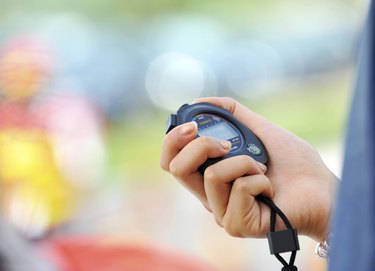
If you and your child are searching for a good experiment for your local school district science fair and you've never done one before, don't panic -- there are many experiments you can choose from. Experiments that involve exercise and heart rate are relatively easy to do and don't require much in the way of materials.
Materials
Video of the Day
When you do a science fair project you need to start out with a theory or prediction and develop a testing method and list of materials for your project. The materials you need for many heart rate experiments are easy to come by: A clock with a second hand or a stopwatch, a pencil and a science notebook or recording sheet. In some experiments you'll also want simple exercise equipment, such as a jump rope or bicycle.
Video of the Day
Sample Experiment
A simple experiment is predicting which type of physical activity will raise your heart rate the most. For example, you can test running, walking, riding a bike and jumping rope. After making your prediction, establish a baseline by measuring your resting heart rate. Before starting each activity, make sure to measure your resting heart rate. Leave enough time between activities so that your heart rate returns to its normal resting level. Do each type of exercise for 15 minutes and measure heart rate after 0, 1, 5, 10 and 15 minutes of the activity. You take your heart rate just before you start to ensure your heart rate is back at its resting rate before you start measuring a new activity. Create a graph that shows time vs. heart rate for each.
Variations
There are several variations you can use with the experiment that measures which activity raises heart rate the most. For example, make a prediction about which activity will increase your heart rate the fastest, thus causing the greatest slope on your graph. Or, predict which activity is best for elevating your heart rate to your target zone for aerobic exercise, which is 50 to 75 percent of your maximum heart rate. Calculate maximum heart rate with the simple formula 220 minus age.
Another Basic Experiment
Another experiment simply measures the effect of exercise on the human heart. You'll make a prediction about the effect steady exercise such as walking or stepping on and off of a stair for a chosen number of minutes will have. For example, you'll predict that a person's heart rate will continue to increase over time when an exercise is performed at a steady pace. You will measure resting heart rate and then measure heart rate at preset intervals. Perform three or more trials and use an average based on the three trials. For example, in experiment one you may find heart rate goes up to 140 beats per minute after five minutes in the first trial, 148 in the second trial and 146 in the third. The average that you'll use for the five-minute time frame is 145.